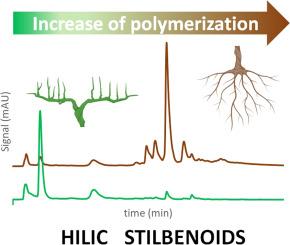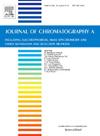用二极管阵列检测、带电气溶胶检测和质谱法通过 HILIC 方法分离多酚:应用于富含二苯乙烯类化合物的葡萄提取物。
IF 3.8
2区 化学
Q1 BIOCHEMICAL RESEARCH METHODS
引用次数: 0
摘要
植物提取物的表征通常采用反相液相色谱法,但 HILIC 等新型补充方法的开发提供了一种正交方法。本研究评估了五种 HILIC 固定相,以评估它们保留多酚的能力。这些固定相的选择涵盖了主要的不同 HILIC 机制:裸硅石、带乙烯桥的硅石、中性酰胺、氨基和齐聚物。筛选共使用了 31 种多酚标准品,包括 9 种芪类化合物、8 种黄酮类化合物、6 种花青素和 8 种酚酸。测试了三种不同的检测方法:二极管阵列检测器、带电气溶胶检测器和质谱法。结果表明,二氧化硅支架不适合保留多酚,除花青素外,其他多酚没有保留或保留率较低。固定相对酚类物质的保留效果依次为齐聚物、酰胺和氨基。流动相的选择也会影响保留率。含有反式脂肪酸作为 pH 值调节剂的流动相限制了保留率,而甲酸对多酚的保留更为有效。pH 值的变化主要影响可电离化合物(如酚酸),当它们被电离时,pH 值的变化会增加它们的保留率。DAD 非常适合检测具有芳香环的多酚,但峰值波长取决于多酚的结构。CAD 的灵敏度虽然不如 DAD 和 MS,但对于结构相关的化合物,即使采用梯度洗脱,也能提供几乎相似的响应。当化合物之间的分辨具有挑战性时,MS 是首选的定量检测器,天然提取物通常就是这种情况。研究成功证明,使用由聚乙烯亚胺和甲酸基流动相组成的氨基固定相可以获得最佳的 HILIC 条件。这些条件被成功应用于分析葡萄不同部位富含的二苯乙烯类提取物。二苯乙烯类化合物的洗脱顺序与聚合度有关。使用 CAD 后,色谱图更能代表样品成分。这首次证明了将 HILIC 和 CAD 结合起来分析二苯乙烯类化合物的优势,为传统的 RP 分析提供了一种补充方法。本文章由计算机程序翻译,如有差异,请以英文原文为准。

Separation of polyphenols by HILIC methods with diode array detection, charged aerosol detection and mass spectrometry: Application to grapevine extracts rich in stilbenoids
The characterization of plant extracts is usually accomplished by reverse-phase liquid chromatography, but the development of new complementary approaches, such as HILIC, offers an orthogonal method. In this study, five HILIC stationary phases were evaluated to assess their ability to retain polyphenols. They were selected to cover the main different HILIC mechanisms: bare silica; silica with ethylene bridge; neutral amide; amino; zwitterionic. A total of 31 polyphenol standards were used for the screening, including 9 stilbenes, 8 flavonoids, 6 anthocyanins, and 8 phenolic acids. Three different detections were tested: diode array detector, charged aerosol detector and mass spectrometry.
Results indicated that silica supports were not suitable for retaining polyphenols, with no or low retention observed except for anthocyanins. The effectiveness of stationary phases in retention of phenolics following the order related to increased retention: zwitterionic, amide, and amino.
The choice of mobile phase also influenced retention. Mobile phases containing TFA as pH modifier limited retention, while formic acid was found to be more effective for polyphenol retention. Ammonium buffers also improved retention but often compromised peak shape. pH changes mainly impacted ionizable compounds, such as phenolic acids, by increasing their retention when they were ionized.
DAD was wellsuited for detecting polyphenols that possess aromatic rings, though peak wavelengths depend on the structures of the polyphenols. CAD, while less sensitive than DAD and MS, provided an almost similar response for structurally related compounds, even with gradient elution. MS was the preferred detector for quantification when resolution between compounds was challenging, as it is often the case with natural extracts.
The study successfully demonstrated that best HILIC conditions were obtained using an amino stationary phase composed of a polyethylenimine and formic acid-based mobile phase. These conditions were successfully applied to the analysis of stilbenoid-rich extracts from different parts of the vine. The elution order of stilbenoids followed the degree of polymerization. With CAD, the chromatographic profile was more representative of sample composition. It was demonstrated for the first time the interest of a combination of HILIC and CAD for analyzing stilbenes, offering a complementary approach to the classic RP analysis.
求助全文
通过发布文献求助,成功后即可免费获取论文全文。
去求助
来源期刊

Journal of Chromatography A
化学-分析化学
CiteScore
7.90
自引率
14.60%
发文量
742
审稿时长
45 days
期刊介绍:
The Journal of Chromatography A provides a forum for the publication of original research and critical reviews on all aspects of fundamental and applied separation science. The scope of the journal includes chromatography and related techniques, electromigration techniques (e.g. electrophoresis, electrochromatography), hyphenated and other multi-dimensional techniques, sample preparation, and detection methods such as mass spectrometry. Contributions consist mainly of research papers dealing with the theory of separation methods, instrumental developments and analytical and preparative applications of general interest.
 求助内容:
求助内容: 应助结果提醒方式:
应助结果提醒方式:


